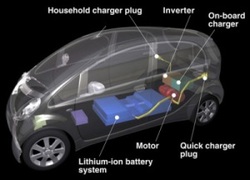How does an electric vehicle work?
 Charging a Detroit Electric car, 1919.
Charging a Detroit Electric car, 1919.
An electric car is powered by an electric motor instead of a petrol engine. The electric motor gets energy from a controller, which regulates the amount of power—based on the driver’s use of an accelerator pedal. The electric car (also known as electric vehicle or EV) uses energy stored in its rechargeable batteries, which are recharged by common household electricity.
Thus an electric vehicle will have three basic components :
The energy storage unit will have a way to store power. A chemical battery is the most common energy storage technology currently, although it can be different - for example - A fuel cell (which gets its electricity from hydrogen rather than a battery pack), can be used instead of a chemical battery as the energy storage unit.
The controller acts as a pipeline or gateway to the electric motor.. The controller will do other things too - it moderates the power, will also act as a converter - converts power from DC to AC, or it might also increase or decrease the amperage etc. The controller is the brains of the system.
The electric motor, which is the propulsion system, converts the electric power and converts this into physical energy for movement.
The whole system is a much simpler, more efficient device than the combustion engine found in most cars, enabling you to get the most mileage for your charge.
Thus an electric vehicle will have three basic components :
- Energy Storage Unit
- Controller
- Propulsion system
The energy storage unit will have a way to store power. A chemical battery is the most common energy storage technology currently, although it can be different - for example - A fuel cell (which gets its electricity from hydrogen rather than a battery pack), can be used instead of a chemical battery as the energy storage unit.
The controller acts as a pipeline or gateway to the electric motor.. The controller will do other things too - it moderates the power, will also act as a converter - converts power from DC to AC, or it might also increase or decrease the amperage etc. The controller is the brains of the system.
The electric motor, which is the propulsion system, converts the electric power and converts this into physical energy for movement.
The whole system is a much simpler, more efficient device than the combustion engine found in most cars, enabling you to get the most mileage for your charge.
 EV internals
EV internals
Historically, EVs have not been widely adopted because of limited driving range before needing to be recharged, long recharging times, and a lack of commitment by automakers to produce and market electric cars that have all the creature comforts of petrol-powered cars. That’s changing. As battery technology improves—simultaneously increasing energy storage and reducing cost—major automakers are expected to begin introducing a new generation of electric cars.
Electric cars produce no tailpipe emissions, reduce our dependency on oil, and are cheaper to operate. Of course, the process of producing the electricity moves the emissions further upstream to the utility company’s smokestack—but even dirty electricity used in electric cars usually reduces our collective carbon footprint.
Another factor is convenience - Let's not forget two important points: charging up at home means never going to a petrol station—and electric cars require almost none of the maintenance, like oil changes and emissions checks, that internal combustion cars require.
Electric motors develop their highest torque from zero rpms—meaning fast (and silent) zero-to-60 acceleration times.
Electric cars produce no tailpipe emissions, reduce our dependency on oil, and are cheaper to operate. Of course, the process of producing the electricity moves the emissions further upstream to the utility company’s smokestack—but even dirty electricity used in electric cars usually reduces our collective carbon footprint.
Another factor is convenience - Let's not forget two important points: charging up at home means never going to a petrol station—and electric cars require almost none of the maintenance, like oil changes and emissions checks, that internal combustion cars require.
Electric motors develop their highest torque from zero rpms—meaning fast (and silent) zero-to-60 acceleration times.
Comments
Post a Comment